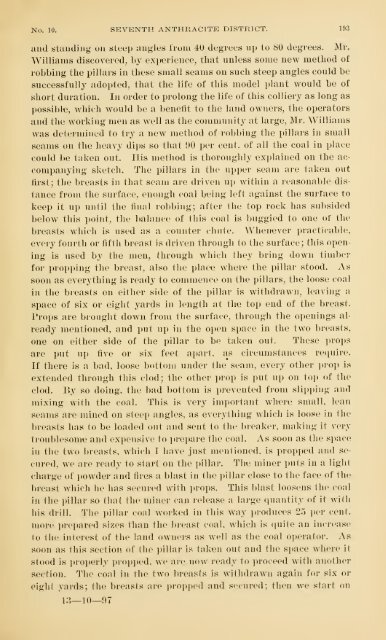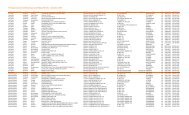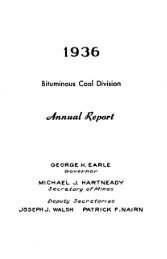- Page 2:
tIniversitybfSctanton Thelihrary ow
- Page 9 and 10:
Official Document. No. 10. REPORT B
- Page 11 and 12:
Official Document, No. ]0. le:ttkr
- Page 13 and 14:
Official Docum nt. No. 10. CONTENTS
- Page 15 and 16:
Official Document, No. 10. INTRODUC
- Page 18 and 19:
Dl/iGR/fM, SHOW/NG TH£ NUMBER OF P
- Page 22 and 23:
0//9G/?/?/W, SHOWING THE NUMBER OF
- Page 25 and 26:
No. 10. MINE INSPECTORS' REPORT. ix
- Page 27 and 28:
No. 10. MINE INSPECTORS' REPORT. Th
- Page 29 and 30:
No. 10. MINE INSPECTORS' REPORT. xi
- Page 31 and 32:
— No. 10. MINE INSPECTORS' REPORT
- Page 33 and 34:
No. 10. MINE INSPECTORS' REPORT. xv
- Page 35 and 36:
No. 10. MINE INSPECTORS' REPORT. xi
- Page 37:
No. 10. MINE INSPECTORS' REPORT. xx
- Page 41 and 42:
No. 10. MINE INSPECTORS' REPORT. xx
- Page 43 and 44:
No. 10. MINE INSPECTORS' REPORT. o
- Page 45 and 46:
No. 10 MINE INSPECTORS' REPORT. a
- Page 47 and 48:
No. 10 MINE INSPECTORS' REPORT. xxl
- Page 49 and 50:
No. 10. MINE INSPECTORS' REPORT. xx
- Page 51 and 52:
No 10. MINE INSPECTORS' REPORT. oc^
- Page 54 and 55:
d a o a Q rid s !5 o
- Page 56:
INTRODUCTORY TO Off. Doc. than we c
- Page 60 and 61:
xxxviii INTRODUCTORY TO Off. Doc. B
- Page 62 and 63:
— xl INTRODUCTORY TO Off. Doc. th
- Page 64 and 65:
xlii INTRODUCTORY TO Off. Doc. weig
- Page 66 and 67:
| xliv INTRODUCTORY TO Off. Doc. Cu
- Page 68 and 69:
xlvi INTRODUCTORY TO Off. Doe. Insi
- Page 70 and 71:
xlviii INTRODUCTORY TO Off. Doc. La
- Page 72 and 73:
1 INTRODUCTORY TO Off. Doc. fairly
- Page 74 and 75:
(Hi)
- Page 76 and 77:
^1 \!/- \C', ^' ^
- Page 78 and 79:
Ivi MINING LAWS OF PENNSYLVANIA. Of
- Page 80 and 81:
Iviii MINING LAWS OF PENNSYLVANIA.
- Page 82 and 83:
Ix MINING LAWS OF PENNSYLVANIA. Off
- Page 84 and 85:
Ixii MINING LAWS OF PENNSYLVANIA. O
- Page 86 and 87:
' Ixiv MINING LAWS OF PENNSYLVANIA.
- Page 88 and 89:
Ixvi MINING LAWS OF PENNSYLVANIA. O
- Page 90 and 91:
Ixviii MINING LAWS OF PENNSYLVANIA.
- Page 92 and 93:
Ixx MINING LAWS OF PENNSYLVANIA. Of
- Page 94 and 95:
Ixxii MINING LAWS OP PENNSYLVANIA.
- Page 96 and 97:
Ixxiv MINING LAWS OF PENNSYLVANIA.
- Page 98 and 99:
Ixxvi MINING LAWS OF PENNSYLVANIA.
- Page 100 and 101:
Ixxviii MINING LAWS OF PENNSYLVANIA
- Page 102 and 103:
Ixxx MINING LAWS OF PENNSYLVANIA. O
- Page 104 and 105:
Ixxxii MINING LAWS OF PENNSYLVANIA.
- Page 106 and 107:
Ixxxiv MINING LAWS OF PENNSYLVANIA.
- Page 108 and 109:
Ixxxvi MINING LAWS OF PENNSYLVANIA.
- Page 110 and 111:
Ixxxviii MINING LAWS OF PENNSYLVANI
- Page 112 and 113:
xc MINING LAWS OF PENNSYLVANIA. Off
- Page 114 and 115:
xcii MINING LAWS OF PENNSYLVANIA. O
- Page 116 and 117:
xciv MINING LAWS OF PENNSYLVANIA. O
- Page 118 and 119:
xcvi MINING LAWS OF PENNSYLVANIA. O
- Page 120 and 121:
xcviii MINING LAWS OF PENNSYLVANIA.
- Page 122 and 123:
c MINING LAWS OF PENNSYLVANIA. Off.
- Page 124 and 125:
cii MINING LAWS OP PENNSYLVANIA. Of
- Page 126 and 127:
civ MINING LAWS OF PENNSYLVANIA. Of
- Page 129 and 130:
No. 10. MINING LAWS OF PENNSYLVANIA
- Page 131 and 132:
No. 10. MINING LAWS OF PENNSYLVANIA
- Page 133 and 134:
No. 10. MINING LAWS OF PENNSYLVANIA
- Page 135 and 136:
No. 10. MINING LAWS OF PENNSYLVANIA
- Page 137 and 138:
No. 10. MINING LAWS OF PENNSYLVANIA
- Page 139 and 140:
No. 10. MINING LAWS OF PENNSYLVANIA
- Page 141 and 142:
No. 10. MINING LAWS OF PENNSYLVANIA
- Page 143 and 144:
No. 10. MINING LAWS OF PENNSYLVANIA
- Page 145 and 146:
No. 10. MINING LAWS OF PENNSYLVANIA
- Page 147 and 148:
No. 10. MINING LAWS OF PENNSYLVANIA
- Page 149 and 150:
No. 10. MINING LAWS OF PENNSYLVANIA
- Page 151 and 152:
No. 10. MINING JLAWS OF PENNSYLVANI
- Page 153 and 154:
No. 10. MINING LAWS OF PENNSYLVANIA
- Page 155 and 156:
No. 10. MINING LAWS OF PENNSYLVANIA
- Page 157 and 158:
No. 10. MINING LAWS OF PENNSYLVANIA
- Page 159 and 160:
No. 10. MINING LAWS OF PENNSYLVANIA
- Page 161 and 162:
No. 10. MINING LAWS OF PENNSYLVANIA
- Page 163 and 164:
ANTHRiClTE Mil DISTRICTS. (cxli)
- Page 165 and 166:
Official Document, No. 10. First An
- Page 167 and 168:
No. 10. FIRST ANTHRACITE DISTRICT.
- Page 169 and 170:
No. 10. FIRST ANTHRACITE DISTRICT.
- Page 171 and 172:
No. 10. FIRST ANTHRACITE DISTRICT.
- Page 173 and 174:
No 10. FIRST ANTHRACITE DISTRICT.
- Page 175 and 176:
No. 10. FIRST ANTHRACITE DISTRICT.
- Page 177 and 178:
No. 10. FIRST ANTHRACITE DISTRICT.
- Page 179 and 180:
No. 10. FIRST ANTHRACITE DISTRICT.
- Page 181 and 182:
No 10. FIRST ANTHRACITE DISTRICT. 1
- Page 183 and 184:
, ' , C ' ,tfl ^ No. 10. FIRST ANTH
- Page 185 and 186:
' S - I No. 10. FIRST ANTHRACITE DI
- Page 187 and 188:
- I No. 10. FIRST ANTHRACITE DISTRI
- Page 189 and 190:
Official Document, No. 10. Second A
- Page 191 and 192:
No. 10. SECOND ANTHRACITE DISTRICT.
- Page 193 and 194:
No. 10. SECOND ANTHRACITE DISTRICT.
- Page 195 and 196:
No. 10. SECOND ANTHRACITE DISTRICT.
- Page 197 and 198:
No. 10. SECOND ANTHRACITE DISTRICT.
- Page 199 and 200:
No. 10. SECOND ANTHRACITE DISTRICT.
- Page 201 and 202:
No. 10. SECOND ANTHRACITE DISTRICT.
- Page 203 and 204:
No. 10. SECOND ANTHRACITE DISTRICT.
- Page 205 and 206:
I Oj I V} ^ cd ; I oi oi ( ; c ; c
- Page 207 and 208:
No. 10. SECOND ANTHRACITE DISTRICT.
- Page 209 and 210:
1 No. 10. SECOND ANTHRACITE DISTRIC
- Page 211 and 212:
No. 10. SECOND ANTHRACITE DISTRICT.
- Page 213 and 214:
j-j No. 10. SECOND ANTHRACITE DISTR
- Page 215:
[^ m
- Page 218 and 219:
Accident. Cause Nature 52 REPORT OF
- Page 220 and 221:
_ * 54 REPORT OF THE INSPECTORS OF
- Page 222 and 223:
5 - .^ 4-> *r- 1 56 REPORT OF THE I
- Page 224 and 225:
, M 58 REPORT OP THE INSPECTORS OP
- Page 226 and 227:
60 REPORT OF THE INSPECTORS OF MINE
- Page 228 and 229:
A^ k -^ ^11 m p~ (62)
- Page 230 and 231:
64 REPORT OF THE INSPECTORS OF MINE
- Page 232 and 233:
66 REPORT OF THE INSPECTORS OF MINE
- Page 234 and 235:
68 REPORT OF THE INSPECTORS OF MINE
- Page 236:
Mount L okoutC olliery WyoTTiiRg.Pa
- Page 240 and 241:
70 REPORT OF THE INSPECTORS OF MINE
- Page 242 and 243:
1 fS : aa>>;^>^>^>^x>^>[>^ . M 72 R
- Page 244 and 245:
74 REPORT OF THE INSPECTORS OF MINE
- Page 246 and 247:
76 REPORT OF THE INSPECTORS OF MINE
- Page 248 and 249:
78 REPORT OP THE INSPECTORS OF MINE
- Page 250 and 251:
80 REPORT OF THE INSPECTORS OF MINE
- Page 252 and 253:
- w - 82 REPORT OF THE INSPECTORS O
- Page 254 and 255:
- i 1 — 84 REPORT OF THE INSPECTO
- Page 256 and 257:
86 REPORT OF THE INSPECTORS OF MINE
- Page 258 and 259:
88 REPORT OF THE INSPECTORS OF MINE
- Page 260 and 261:
90 REPORT OF THE INSPECTORS OF MINE
- Page 262 and 263:
92 REPORT OF THE INSPECTORS OF MINE
- Page 264 and 265:
94 REPORT OF THE INSPECTORS OF MINE
- Page 266 and 267:
96 REPORT OF THE INSPECTORS OF MINE
- Page 268 and 269:
98 REPORT OF THE INSPECTORS OF MINE
- Page 270 and 271:
100 REPORT OF THE INSPECTORS OF MIN
- Page 272 and 273:
102 REPtJRT OF THE INSPECTORS OF MI
- Page 274 and 275:
104 REPORT OF THE INSPECTORS OF MIN
- Page 276 and 277:
106 REPORT OF THE INSPECTORS OF MIN
- Page 278 and 279:
108 REPORT OF THE INSPECTORS OF MIN
- Page 280 and 281:
110 REPORT OF THE INSPECTORS OF MIN
- Page 282 and 283:
108.50 104.30 137.60 168.80 150.20
- Page 284 and 285:
114 REPORT OF THE INSPECTORS OF MIN
- Page 286 and 287:
116 REPORT OF THE INSPECTORS OF MIN
- Page 288 and 289:
118 REPORT OF THE INSPECTORS OF MIN
- Page 290 and 291:
120 REPORT OF THE INSPECTORS OF MIN
- Page 292 and 293:
122 REPORT OF THE INSPECTORS OF MIN
- Page 294 and 295:
(124)
- Page 296 and 297:
126 REPORT OF THE INSPECTORS OF MIN
- Page 298 and 299:
128 REPORT OF THE INSPECTORS OF MIN
- Page 300 and 301:
130 REPORT OF THE INSPECTORS OF MIN
- Page 302 and 303:
132 REPORT OF THE INSPECTORS OP MIN
- Page 304:
134 REPORT OF THE INSPECTORS OF MIN
- Page 307 and 308:
No. 10. FIFTH ANTHRACITE DISTRICT.
- Page 310:
) CROS.S^C0MFOtJ>T)-9ltRFACE=C0NDEN
- Page 314:
138 REPORT OF THE INSPECTORS OF MIN
- Page 319 and 320:
No. 10. FIFTH ANTHRACITE DISTRICT.
- Page 321 and 322:
. Q^ ; M ,^ . No. 10. FIFTH ANTHRAC
- Page 323 and 324:
No. 10. FIFTH ANTHRACITE DISTRICT.
- Page 325 and 326: No. 10. FIFTH ANTHRACITE DISTRICT.
- Page 327 and 328: No. 10. FIFTH ANTHRACITE DISTRICT.
- Page 329 and 330: No. 10. FIFTH ANTHIIACITE DISTRICT.
- Page 331 and 332: — ' C -a No. 10. FIFTH ANTHRACITE
- Page 333 and 334: . e ' No. 10. FIFTH ANTHRACITE DIST
- Page 335 and 336: No. 10. FIFTH ANTHRACITE DISTRICT.
- Page 337 and 338: f No. 10. FIFTH ANTHRACITE DISTRICT
- Page 339 and 340: f, . Oj No. 10. FIFTH ANTHRACITE DI
- Page 341 and 342: Official Document, No. ]0. Sixth An
- Page 343 and 344: No. 10. SIXTH ANTHRACITE DISTRICT.
- Page 345 and 346: No. 10. SIXTH ANTHRACITE DISTRICT.
- Page 347 and 348: No. 10. SIXTH ANTHRACITE DISTRICT.
- Page 349 and 350: No. ]0. SIXTH ANTHRACITE DISTRICT.
- Page 351 and 352: No. 10. SIXTH ANTHRACITE DISTRICT.
- Page 353 and 354: No. 10. SIXTH ANTHRACITE DISTRICT.
- Page 355 and 356: No. 10. SIXTH ANTHRACITE DISTRICT.
- Page 357 and 358: ' I .2 No. 10. SIXTH ANTHRACITE DIS
- Page 359 and 360: . ; No. 10. SIXTH ANTHRACITE DISTRI
- Page 361 and 362: No. le. SIXTH ANTHRACITE DISTRICT.
- Page 363 and 364: 1 C , o - No 10. SIXTH ANTHRACITE D
- Page 365 and 366: ' o . OJ i c: ' ' No. 10. SIXTH ANT
- Page 367 and 368: I ' No. 10. SIXTH ANTHRACITE DISTRI
- Page 369 and 370: Official Document, No. 10. SEVENTH
- Page 371 and 372: No. 10. SEVENTH ANTHRACITE DISTRICT
- Page 375: I •/^^^•^r^^p^n
- Page 379 and 380: No. 10. SEVENTH ANTHRACITE DISTRICT
- Page 381 and 382: ' No. 10. SEVENTH ANTHRACITE DISTRI
- Page 383 and 384: No. 10. SEVENTH ANTHRACITE DISTRICT
- Page 385 and 386: No. 10. SEVENTH ANTHRACITE DISTRICT
- Page 387 and 388: No. 10. SEVENTH ANTHRACITE DISTRICT
- Page 389: ' •*-* X ; o : o . 3 No. 10. SEVE
- Page 392 and 393: 208 REPORT OF THE INSPECTORS OF MIN
- Page 394 and 395: 210 REPOKT OF THE INSPECTORS OF MIN
- Page 396 and 397: 212 REPORT OF THE INSPECTORS OF MIN
- Page 398 and 399: 214 REPORT OF THE INSPECTORS OF MIN
- Page 400 and 401: 216 REPORT OF THE INSPECTORS OF MIN
- Page 402 and 403: 218 REPORT OF THE INSPECTORS OF MIN
- Page 404 and 405: 220 REPORT OF THE INSPECTORS OF MIN
- Page 406 and 407: 222 REPORT OF THE INSPECTORS OF MIN
- Page 408 and 409: 224 REPORT OF THE INSPECTORS OF MIN
- Page 410 and 411: ) o 226 REPORT OF THE INSPECTORS OP
- Page 412 and 413: I I « 228 REPORT OF THE INSPECTORS
- Page 414 and 415: ^'IJ^^J!\X (230)
- Page 416 and 417: (232)
- Page 418 and 419: 234 REPORT OF THE INSPECTORS OF MIN
- Page 420 and 421: 236 REPORT OF THE INSPECTORS OF MIN
- Page 422 and 423: 238 REPORT OF THE INSPECTORS OF MIN
- Page 424 and 425: 240 REPORT OF THE INSPECTORS OF MIN
- Page 426 and 427:
242 REPORT OF THE INSPECTORS OF MIN
- Page 428 and 429:
244 REPORT OF THE INSPECTORS OF MIN
- Page 430 and 431:
246 REPORT OF THE INSPECTORS OF MIN
- Page 432 and 433:
248 REPORT OF THE INSPECTORS OF MIN
- Page 434 and 435:
. . .0000 • •§§2= ^ ; ; . ' 0
- Page 436 and 437:
252 REPORT OF THE INSPECTORS OF MIN
- Page 438 and 439:
254 REPORT OF THE INSPECTORS OF MIN
- Page 440 and 441:
256 REPORT OF THE INSPECTORS OF MIN
- Page 442 and 443:
258 REPORT OF THE INSPECTORS OF MIN
- Page 444 and 445:
( 260)
- Page 446 and 447:
1 262 REPORT OF THE INSPECTORS OF M
- Page 448 and 449:
264 REPORT OF THE INSPECTORS OF MIN
- Page 450 and 451:
266 REPORT OF THE INSPECTORS OF MIN
- Page 452 and 453:
2GS REPORT OF THE INSPECTORS OF MIN
- Page 454 and 455:
270 REPORT OF THE INSPECTORS OF MIN
- Page 456 and 457:
272 REPORT OF THE INSPECTORS OF MIN
- Page 458 and 459:
274 REPORT OF THE INSPECTORS OF MIN
- Page 460 and 461:
276 REPORT OF THE INSPECTORS OF MIN
- Page 462 and 463:
278 REPORT OF THE INSPECTORS OF MIN
- Page 464 and 465:
280 REPORT OF THE INSPECTORS OF MIN
- Page 466 and 467:
282 REPORT OF THE INSPECTORS OF MIN
- Page 470:
n ARBDN COAL COMPANY'S U"
- Page 474 and 475:
284 REPORT OF THE INSPECTORS OF MIN
- Page 476 and 477:
286 REPORT OP THE INSPECTORS OF MIN
- Page 478 and 479:
288 REPORT OF THE INSPECTORS OF MIN
- Page 480 and 481:
290 REPORT OF THE INSPECTORS OF MIN
- Page 482 and 483:
I 292 REPORT OF THE INSPECTORS OF M
- Page 484 and 485:
294 REPORT OF THE INSPECTORS OP MIN
- Page 486 and 487:
( 296)
- Page 488 and 489:
298 REPORT OF THE INSPECTORS OF MIN
- Page 490 and 491:
300 REPORT OF THE INSPECTORS OF MIN
- Page 492 and 493:
302 REPORT OF THE INSPECTORS OF MIN
- Page 494 and 495:
304 REPORT OP THE INSPECTORS OF MIN
- Page 496 and 497:
306 REPORT OP THE INSPECTORS OF MIN
- Page 498 and 499:
308 REPORT OF THE INSPECTORS OF MIN
- Page 500 and 501:
310 REPORT OF THE INSPECTORS OF MIN
- Page 502 and 503:
312 REPORT OF THE INSPECTORS OF MIN
- Page 504 and 505:
314 REPORT OF THE INSPECTORS OF MIN
- Page 506 and 507:
316 REPORT OF THE INSPECTORS OF MIN
- Page 508 and 509:
318 REPORT OF THE INSPECTORS OF MIN
- Page 510 and 511:
I « ' 320 REPORT OF THE INSPECTORS
- Page 512 and 513:
322 REPORT OF THE INSPECTORS OF MIN
- Page 514 and 515:
324 REPORT OF THE INSPECTORS OF MIN
- Page 516 and 517:
326 REPORT OF THE INSPECTORS OF MIN
- Page 518 and 519:
328 REPORT OF THE INSPECTORS OF MIN
- Page 520 and 521:
330 REPORT OF THE INSPECTORS OF MIN
- Page 522 and 523:
332 REPORT OF THE INSPECTORS OF MIN
- Page 524 and 525:
' - • • 334 REPORT OP THE INSPE
- Page 526 and 527:
336 REPORT OF THE INSPECTORS OF MIN
- Page 528 and 529:
338 REPORT OF THE INSPECTORS OF MIN
- Page 530 and 531:
i aoi ! tt 340 REPORT OF THE INSPEC
- Page 532 and 533:
(342)
- Page 534 and 535:
344 REPORT OF THE INSPECTORS OF MIN
- Page 536 and 537:
346 REPORT OF THE INSPECTORS OF MIN
- Page 538 and 539:
348 REPORT OF THE INSPECTORS OF MIN
- Page 540 and 541:
350 REPORT OF THE INSPECTORS OF MIN
- Page 542 and 543:
352 REPORT OF THE INSPECTORS OF MIN
- Page 544 and 545:
354 REPORT OF THE INSPECTORS OF MIN
- Page 546 and 547:
356 REPORT OF THE INSPECTORS OF MIN
- Page 548 and 549:
358 REPORT OF THE INSPECTORS OP MIN
- Page 550 and 551:
360 REPORT OF THE INSPECTORS OF MIN
- Page 552 and 553:
362 REPORT OF THE INSPECTORS OF MIN
- Page 554 and 555:
• .Q V* ^ ^ -C ^- • 364 REPORT
- Page 556 and 557:
366 REPORT OF THE INSPECTORS OF MIN
- Page 558 and 559:
368 REPORT OF THE INSPECTORS OF MIN
- Page 560 and 561:
370 tlfiPORT OP THE INSPECTORS OF M
- Page 562 and 563:
372 REPORT OF THE INSPECTORS OF MIN
- Page 564 and 565:
374 REPORT OF THE INSPECTORS OF MIN
- Page 566 and 567:
376 REPORT OF THE INSPECTORS OF MIN
- Page 568 and 569:
378 REPORT OF THE INSPECTORS OF MIN
- Page 570 and 571:
380 REPORT OF THE INSPECTORS OF MIN
- Page 572 and 573:
382 REPORT OF THE INSPECTORS OF MIN
- Page 574 and 575:
384 REPORT OF THE INSPECTORS OF MIN
- Page 576 and 577:
386 REPORT OF THE INSPECTORS OF MIN
- Page 578 and 579:
^^8 REPORT OF THE INSPECTORS OF MIN
- Page 580 and 581:
, . . . .^.g^^ T 390 REPORT OF THE
- Page 582 and 583:
392 REPORT OF THE INSPECTORS OF MIN
- Page 584 and 585:
— 394 REPORT OF THE INSPECTORS OF
- Page 586 and 587:
396 REPORT OF THE INSPECTORS OF MIN
- Page 588 and 589:
(398)
- Page 590 and 591:
400 REPORT OF THE INSPECTORS OF MIN
- Page 592 and 593:
402 REPORT OF THE INSPECTORS OF MIN
- Page 594 and 595:
404 xiEPORT OF THE INSPECTORS OF MI
- Page 596 and 597:
406 REPORT OF THE INSi'KCTORS OF MI
- Page 598 and 599:
408 REPORT OF THE INSPECTORS OF MIN
- Page 600 and 601:
410 REPORT OF THE INSPECTORS OF MIN
- Page 602 and 603:
412 REPORT OF THE INSPECTORS OF MIN
- Page 604 and 605:
414 REPORT OF THE INSPECTORS OF MIN
- Page 606 and 607:
I ; o : c 416 REPORT OF THE INSPECT
- Page 608 and 609:
418 REPORT OF THE INSPECTORS OF MIN
- Page 610 and 611:
420 REPORT OF THE INSPECTORS OF MIN
- Page 612 and 613:
422 REPORT OF THE INSPECTORS OF MIN
- Page 614 and 615:
424 REPORT OF THE INSPECTORS OF MIN
- Page 616 and 617:
(426)
- Page 618 and 619:
428 REPORT OF THE INSPECTORS OF MIN
- Page 620 and 621:
430 REPORT OF THE INSPECTORS OF MIN
- Page 622 and 623:
432 HEPORT OF THE INSPECTORS OF MIN
- Page 624 and 625:
434 REPORT OF THE INSPECTORS OF MIN
- Page 626 and 627:
436 REPORT OF THE INSPECTORS OF MIN
- Page 628 and 629:
438 KEPOKT OF THE INSPECTOKS OF MIN
- Page 630 and 631:
440 REPORT OF THE INSPECTORS OP MIN
- Page 632 and 633:
442 REPORT OF THE INSPECTORS OF MIN
- Page 634 and 635:
444 REPORT OF THE INSPECTORS OF MIN
- Page 636 and 637:
446 REPORT OF THE INSPECTORS OF MIN
- Page 638 and 639:
448 REPORT OP THE INSPECTORS OF MIN
- Page 640 and 641:
450 REPORT OP THE INSPECTORS OF MIN
- Page 642:
452 REPORT OF THE INSPECTORS OF MIN
- Page 645:
2/0 i*i;t- i^JU^^OitM. d'^^ ^ 'f/-^
- Page 648 and 649:
;„ 454 REPORT OP THE INSPECTORS O
- Page 650 and 651:
456 REPORT OF THE INSPECTORS OF MIN
- Page 652 and 653:
458 REPORT OF THE INSPECTORS OP MIN
- Page 654 and 655:
460 REPORT OF THE INSPECTORS OF MIN
- Page 656 and 657:
462 REPORT OF THE INSPECTORS OF MIN
- Page 658 and 659:
464 REPORT OF THE INSPECTORS OF MIN
- Page 660:
466 REPORT OF THE INSPECTORS OF MIN
- Page 663 and 664:
No. 10. NINTH BITUMINOUS DISTRICT.
- Page 665 and 666:
No. 10. NINTH BITUMINOUS DISTRICT.
- Page 667 and 668:
No. 10. NINTH BITUMINOUS DISTRICT.
- Page 669 and 670:
No. 10. NINTH BITUMINOUS DISTRICT.
- Page 671 and 672:
No. 10 NINTH BITUMINOUS DISTRICT. 4
- Page 673 and 674:
No. 10. NINTH BITUMINOUS DISTRICT.
- Page 675 and 676:
No. 10. NINTH BITUMINOUS DISTRICT.
- Page 677 and 678:
No. 10. NINTH BITUMINOUS DISTRICT.
- Page 679 and 680:
No. 10. NINTH BITUMINOUS DISTRICT.
- Page 681 and 682:
) Official Document, No. ](). Tenth
- Page 683 and 684:
No. 10. TENTH BITUMINOUS DISTRICT.
- Page 685 and 686:
I 8 No. 10. TENTH BITUMINOUS DISTRI
- Page 687 and 688:
No. 10. TENTH BITUMINOUS DISTRICT.
- Page 689 and 690:
No. 10. TENTH BITUMINOUS DISTRICT.
- Page 691 and 692:
No. 10. TKNTH BITUMINOUS DISTRICT.
- Page 693 and 694:
No. 10. TENTH BITUMINOUS DISTRICT.
- Page 695 and 696:
No. 10. TENTH BITUMINOUS DISTRICT.
- Page 697 and 698:
No. 10. TENTH BITUMINOUS DISTRICT.
- Page 699 and 700:
Nc. 10. TENTH BITUMINOUS DISTRICT.
- Page 701 and 702:
' No. 10. TENTH BITUMINOUS DISTRICT
- Page 703 and 704:
No. 10. TENTH BITTTMINOUS DISTRICT.
- Page 705 and 706:
No. 10. TENTH BITUMINOUS DISTRICT.
- Page 707 and 708:
No. 10. TENTH BITUMINOUS DISTRICT.
- Page 709 and 710:
Official Document, No. 10. NDEX. Pa
- Page 711 and 712:
No. ]0. INDEX. 515 Page. Table C, n
- Page 713 and 714:
. No. 10. INDEX. 517 Page. Table No
- Page 715 and 716:
No. 10. INDEX. 519 Page. Table No.
- Page 723:
REF TN805.P1A3 '897 neper. nt,heBu,




![1945 Anthracite Annual Report Districts 19 - 25 [Adobe pdf - 9148Kb]](https://img.yumpu.com/50308099/1/190x119/1945-anthracite-annual-report-districts-19-25-adobe-pdf-9148kb.jpg?quality=85)


![1937 Anthracite Annual Report Districts 1 - 11 [Adobe pdf - 9394Kb]](https://img.yumpu.com/43539962/1/190x119/1937-anthracite-annual-report-districts-1-11-adobe-pdf-9394kb.jpg?quality=85)






![1931 Anthracite Annual Report Districts 1 - 11 [Adobe pdf - 8007Kb]](https://img.yumpu.com/39427789/1/190x119/1931-anthracite-annual-report-districts-1-11-adobe-pdf-8007kb.jpg?quality=85)

